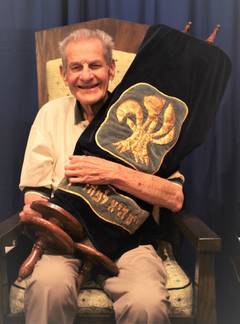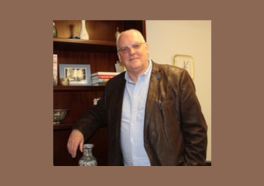- About Us
- Connect
- Learn
- Jewish Life
- Music
- Events
- Give
- Join Us
"Love Is as strong as death" - kol nidre 5784/2023
09/27/2023 01:06:41 PM
| Author | |
| Date Added | |
| Automatically create summary | |
| Summary |
We have every reason to trust science. Biology teaches us that death is the end of life. When a heart stops beating, the life force is no more.
However, for many generations, Jewish tradition has reflected the idea that death does not mean the end of life.
Our early Israelite ancestors believed that those who died remained tethered to earth in a shadowy existence. There is archeological evidence that ancient Israelites left food and drink in burial caves so that their family members would have sustenance after they died.
The Hebrew Bible often refers to the death of an individual as that person “being gathered to his kin.” After our life ends, we go where our ancestors went before us.
Even further, the Torah prohibits consulting with ghosts or attempting to communicate with the dead. When the Torah prohibits something, this means people were doing it. Why would people want to converse with the dead? Because they believed that those who have died may have important information for the living or may even be able to act favorably on their behalf.
Today some Jews visit graves of loved ones before and during the High Holy Days. This custom has its origin in the idea that during this season of judgment, we need the spirits of our loved ones to intercede on our behalf, so that God will seal us in the Book of Life for a good year.
Yet there are people who follow this custom for an entirely different reason. They do not believe that they stand by the graves of their loved ones to ask them to intercede with God on their behalf. Some of them do not even believe in the traditional idea of God at all. They go to the graveside as an act of love, a declaration that death has not severed their connection to those who have died.
Earlier this year I officiated at a funeral for a woman named Lois Wolland. Lois’s family gave me permission to tell you about her final days.
Lois’s husband had died six months earlier after a long decline. The couple first met when they were only fourteen and fifteen years old. Together they sustained a long, loving marriage and raised four children.
Lois suffered from a chronic debilitating condition and needed assistance with daily tasks. Her adult children ensured that she had loving and consistent care throughout her final years. Near the end of Lois’s life, her children moved her to an apartment in the city, close to her daughters. They filled Lois’s apartment with the little figurines of elephants that she had collected throughout the decades.
One evening, Lois, who was barely able to talk, asked her daughters to start packing up her elephant figurines. Lois said that she wanted to take her figurines with her. Her daughters dutifully filled two bags with these elephant figurines and placed others in the bed with Lois.
That evening, Lois said, “Dad is coming to get me tomorrow, but just in case he comes early, don’t wake me up. But Dad is never early, so he will be here tomorrow afternoon.” Because Lois reassured her children that she would see them the following morning, they left the apartment as Lois went to sleep.
The next morning it was clear that Lois’s life was nearing its end. Before she died, Lois said that she saw her own mother and her mother’s brother, both long dead, appear in her room. Early that afternoon, Lois took her last breath. She “was gathered to her kin,” lovingly escorted by her husband of many years.
Many years ago, I stood by the graveside of a young woman who had died after a terrible illness. It was a cloudy, chilly day. The weather reflected the profound sadness we all felt.
After the burial, the young woman’s heartbroken father took me aside. He wanted to tell me about something that had happened earlier on that gray and cloudy morning. He had been in his bedroom getting ready for the funeral when he went into the hallway for a moment. When he returned to the bedroom, he immediately noticed a distinct sunbeam streaming through the clouds and into the window. The sunbeam illuminated the bed where he had placed his suit for the funeral.
“I know it was my daughter,” he said. “She was telling me she was with me, and that she was okay.”
While these words reflected the wishful thinking of a grieving father, there was some truth in his sentiment. Over the years, I heard similar stories from other people. Stories of rare birds, butterflies, or praying mantises appearing out of nowhere shortly after the death of a loved one. Stories of dining room lights flickering when sharing memories of loved ones at the first family holiday gatherings after their death. Stories of feeling the ghostly presence of someone who had died, even smelling the scent of perfume or cigar smoke long associated with that person.
While I never doubted the sincerity of those who told me about their experiences, at the same time, I did not give these stories much thought. Judaism focuses on the here and now. This life matters most. This life deserves our full attention.
Yet Jewish traditions around memory are about life. These traditions are expressions of love and connection. Consider the ritual of yahrzeit, the yearly remembrance of a loved one’s death. We light a yahrzeit candle and remember a face, a voice, or a touch. We hear the name of our loved one, and a memory comes into focus. We say the words of the kaddish, words recited by generations and generations, and feel a spiritual connection that defies precise articulation. More important than any teachings about soul and the afterlife in Judaism are the actions that nurture the connection we feel to those who have died.
We can be certain about the power of these rituals of memory and about the love that gives these rituals their power. At the same time, we can open ourselves to uncertainty. We do not know how Lois Wolland was so certain that her beloved husband would come to get her the following day, and that knowing him, he would be late and would not arrive until the afternoon. We cannot explain all these experiences.
When it comes to death, perhaps we need to consider the possibility that there is an indelible bond between our souls, a connection that endures after death. This can make us cherish more fully our loved ones, whether they sit beside us now or dwell in our memory.
On this sacred night and day of Yom Kippur, the traditions of our people prompt us to confront our own mortality. One day our lives will come to an end. Yet when that day comes, death will not erase us from the bonds of life. Centuries ago, the author of the Biblical book Shir Hashirim, the Song of Songs, wrote: כִּֽי־עַזָּ֤ה כַמָּ֙וֶת֙ אַהֲבָ֔ה
“Love is as strong as death.”
A loving bond connects our spirits, a bond that transcends the grave. May we feel the presence of our loved ones now, in this moment, and as we live our days to come.
Thu, April 24 2025
26 Nisan 5785
Temple israel Happenings
-
Thursday ,
AprApril 24 , 2025 County-Wide Yom HaShoah Commemoration
County-Wide Yom HaShoah Commemoration
Thursday, Apr 24th 12:00pm to 1:00pm
County-Wide Yom HaShoah Commemoration at the Garden of Remembrance, 119 Martine Avenue in White Plains. Temple Israel's rescued Holocaust Torah scroll will be part of the procession of scrolls from Westchester county, and Cantor Hayley Kobilinsky will participate in the program. -
Tuesday ,
AprApril 29 , 2025 Sisterhood Book Group
Sisterhood Book Group
Tuesday, Apr 29th 6:00pm to 8:30pm
NEW DATE! We will be discussing the book "The Frederick Sisters Are Living the Dream" by Jeannie Zusy in person at a congregants' home. The author will be joining us for the discussion. We will have a Pot Luck Dinner to start -
Wednesday ,
AprApril 30 , 2025 Holocaust Education Today: Challenges and Limits by Dr. Werner Steger
Holocaust Education Today: Challenges and Limits by Dr. Werner Steger
Wednesday, Apr 30th 6:00pm to 7:30pm
Dr. Steger serves as the endowed chair for the Greenspan-Handel Trust for Holocaust and Genocide Studies. -
Saturday ,
MayMay 3 , 2025 Midnight Run
Midnight Run
Shabbat, May 3rd 1:00pm to 4:00pm
Volunteers needed. The Midnight Run is a volunteer organization whose goal is to come together as a community in order to feed the homeless of New York City. They coordinate more than 1,000 relief missions per year with volunteers from churches, synagogues, schools and other civic groups to deliver food, clothing, blankets and personal care items to the homeless poor on the streets of New York City.
Events
Today's Calendar
| Yom HaShoah |
: 12:00pm |
: 7:00pm |
Friday Night
: 7:00pm |
Shabbat Day
: 9:30am |
Upcoming Programs & Events
Apr 24 |
Apr 24 |
Apr 29 |
Apr 30 |
May 2 |
This week's Torah portion is Parashat Sh'mini
| Shabbat, Apr 26 |
Yom HaShoah
| Thursday, Apr 24 |




